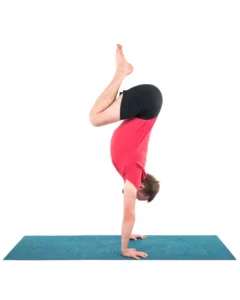Painful Periods? Yoga May Help

Good news for women suffering from menstrual pain and looking for a healthier, more natural approach to improving symptoms: in a study conducted in Taiwan, an eight-week hatha yoga course proved effective in reducing the pain of dysmenorrhea (menstrual cramps). The researchers’ objective was not only to find out if yoga would reduce the pain of menstrual cramps, but if so, why?
They concluded that yoga does in fact reduce pain, and that it may be due to reduction in levels of the amino acid homocysteine—high levels of which have been associated with atherosclerosis (hardening and narrowing of the arteries) heart attack, stroke, and blood clot formation.
The researchers reported on thirty women with chronic menstrual pain and a control group of thirty women without pain. They had the two groups practice hatha yoga for eight weeks, during which time they tested their pain levels with questionnaires and blood tests.
Before the yoga practice began, the women with menstrual cramps had higher levels of homocysteine. At the end of the eight-week practice, both groups of women had lower levels of homocysteine, and the women with dysmenorrhea reported less pain. The researchers also tested nitric oxide, which is associated with inflammation, and found that those levels did not change—implying that the decrease in pain was not due to a decrease in inflammation.
Homocysteine is needed by the body to make protein and build tissue, but high levels of the amino acid are often present in heart disease and other illnesses. Higher levels are sometimes associated with inadequate levels of folic acid (folate) and vitamins B6 and B12, as well as with alcohol consumption and smoking. The best sources of dietary folate include green leafy vegetables, asparagus, romaine lettuce, broccoli, cauliflower, lentils, green peas, beets, and citrus fruits. It’s important to note, however, that more than 1000 mcg of folic acid a day may lead to nervous system damage in those that lack the threshold level of vitamin B12, which most often includes vegans, vegetarians and those over 50.
Vitamins B6 and B12 help the body to use folic acid and are vital nutrients that assist in a range of important activities, including cellular repair, digestion, energy production and immune system function. A deficiency in B6 or B12 will also result in anemia. The good news is that B6 is found in most foods, so deficiency is rare, but B12 deficiency is far more common. The best dietary sources of B vitamins, especially B12, include: meat, poultry, and yeast extracts (brewer’s yeast, Marmite). Other good sources include asparagus, broccoli, spinach, bananas, potatoes, dried apricots, dates, figs, milk, eggs, cheese, yogurt, fish, brown rice and wheat germ. Adding these foods to the diet will sometimes cause homocysteine levels to drop.
All the women in the study experienced lowered levels of homocysteine, while those with menstrual pain and correspondingly higher levels of homocysteine had the greatest improvement. The researchers concluded that yoga may help to restore the endothelial function, which mediates the constricting and opening of blood cell walls to move blood through the body.
Source
Effect of Yoga on Serum Homocysteine and Nitric Oxide Levels in Adolescent Women With and Without Dysmenorrhea. Chien LW, Chang HC, Liu CF, Department of Obstetrics and Gynecology, Taipei Medical University Hospital, Taipei, Taiwan



